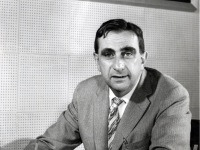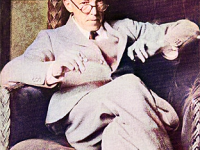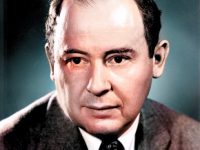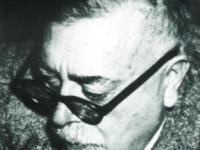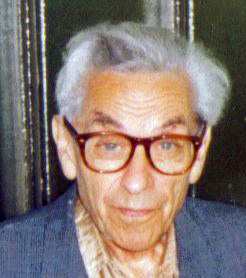
Paul Erdös (1913-1996)
On September 20, 1996, Hungarian mathematician Paul Erdös passed away. He published more scientific papers than any other mathematician in history, with hundreds of collaborators. Thus, he even created a ‘small world’ of its own, the famous club of people that posess an ‘Erdös Number‘. BTW, my Erdös number is 3, i.e. I have published a paper together with a co-author whose Erdös number is 2. In this little game of numbers, Paul Erdös has the Erdös number 0, his direct co-authors have the Erdös number 1. Thus, the Erdös number gives the distance – according to co-authorship of published scientific papers – to the famous Paul Erdös. But who was Paul Erdös and what else is he famous for?
Youth and Education
Paul Erdös was born in Budapest in 1913 into a jewish family and showed an early interest in mathematics. Both of his parents happened to be mathematicians themselves, providing Erdös with the necessary support. While his mother was teaching, Paul was brought up by a German governess. He could already count on three years and with four friends of the family in his head he could calculate how many seconds they already lived. Their genius son was introduced to set theory as well as infinite series at the age of 16 and was awarded the doctorate in mathematics at 21. In 1920 his father returned from Siberian captivity. He had taught himself English in captivity, but without mastering pronunciation, and transferred this accent to his son. Since anti-Semitism was on the rise, he went to Harold Davenport in Manchester with a scholarship in the same year, but travelled far and wide within England and met Hardy [7] in Cambridge, among others.
First Trip to the U.S.
In 1938 he took his first position in the USA, as a scholarship holder, in Princeton (New Jersey). However, he did not keep them for long, as the Princeton directors considered him to be “peculiar and unconventional,” and he accepted Stanislaw Ulam‘s invitation to Madison. Around this time he began to develop the habit of traveling from campus to campus. He never lasted long in one place and travelled back and forth between mathematical institutes until his death.
Almost a Spy
In 1941 Paul Erdős made a trip with his colleagues Arthur Stone and Shizuo Kakutani. They wanted to look out at the sea from an elevation with a tower. Just thinking about math, they missed a sign saying “no admission.” They took some souvenir photos and were later arrested and interrogated by the FBI for espionage. The misunderstanding soon cleared up, but the entry in an FBI file hurt him later in the McCarthy era. Only after the war did he learn of the fate of his relatives in Hungary, many of whom died in the Holocaust. He was very worried about his mother, who had survived the Holocaust. His father had died of a heart attack in 1942. When he visited his mother and friends in Hungary in December 1948 after a break of ten years, he only managed to leave Hungary again in February 1949, as Stalin had sealed off the borders in the beginning Cold War. Then he commuted back and forth between England and the USA for three years before accepting a position at the US University of Notre Dame in 1952.
Troubles with McCarthy
When he wanted to travel to a conference in Amsterdam in 1954, he was told after an investigation before a McCarthy commission that if he left the USA, he would not be allowed to re-enter, which did not stop Erdős from going to that conference. Since the Netherlands and England also imposed travel and residence restrictions on him, he accepted a position at the Hebrew University of Jerusalem in the 1960s. Despite many attempts, he only received a permit to enter the USA again in 1963. Officially no reason was given, from the files it follows that his arrest in 1941 and his contacts to the Chinese number theorist Loo-Keng Hua were the cause.
Mathematical Merits
Paul Erdös loved and lived the mathematics like no other, he made major contributions to the Ramsey theory as well as the probabilistic method. He has discovered a proof for the prime number theorem and Bertrand’s postulate. Erdös published more than 1,500 articles, but even though he has built up a tremendous reputation in the field of mathematics, he never won the greatest mathematical prize, the Fields Medal. The great scientist used mathematics for problem solving as well as socializing, sometimes combining the two of these. He would offer prizes for people, who finished some of his unsolved problems. The prizes ranged from 25$ up to several thousands, but there is no official number on how many prizes he actually gave away. Up to this day you can work on Erdös’ problems, they are administrated by Ronald Graham, a famous mathematician himself.
Coffee and Amphetamins
He slept only four to five hours a day and pushed himself up with coffee, caffeine tablets and amphetamine, which he was prescribed due to depression after his mother’s death. In 1979, his friend Ronald Graham offered him a $500 bet because he worried that Erdős was dependent: he would not be able to last 30 days without stimulants. He lasted the 30 days, but said that the bet had set mathematics back a month because he could not put a thought on paper. After the bet, he resumed amphetamine use.
You may also be wondering, how Erdös managed to work together with 511 collaborators and publish this many papers. Actually it’s simple. He lived a life of a vagabond, traveling from place to place, teaching, writing, researching. Often enough he would just appear at other mathematicians homes saying “my brain is open” and not leaving until the work was done.
Turning Coffee into Theorems…
Erdös was a man seeking the entire freedom, which he found in mathematics. He called men ‘slaves’, women the ‘bosses’, and children were ‘epsilons’, that is how he rolled, never stopping to focus on mathematics, considering all kinds of commitment as distractions. He truly believed in what he was doing all his life, he understood mathematical lectures as prayers and mathematicians as devices for “turning coffee into theorems“. Paul Erdös is to be considered as one of the most active and the most productive mathematicians in history.
John Barrow, Erdos Numbers: A mathematical example of ‘small world’ networks, [7]
References and Further Reading:
- [1] Man Who Loved Only Numbers: Story of Paul Erdos and the Search for Mathematical Truth
, Paul Hoffmann, 1999
- [2] Combinatorics, geometry and probability. A tribute to Paul Erdös
, Béla Bollobás, 1997
- [3] Paul Erdös in the Wikipedia
- [4] Paul Erdös Article by L´aszló Babai on the American Mathematical Society Website
- [5] Paul Erdös at zbMATH
- [6] Paul Erdös at Wikidata
- [7] John Barrow, Erdos Numbers: A mathematical example of ‘small world’ networks,
- [8] G. H. Hardy and the aesthetics of Mathematics, SciHi Blog
- [9] Please Don’t Ignite the Earth’s Atmosphere…, SciHi Blog
- [10] Baker, A.; Bollobas, B. (1999). “Paul Erdős 26 March 1913 – 20 September 1996: Elected For.Mem.R.S. 1989”. Biographical Memoirs of Fellows of the Royal Society. 45: 147–164.
- [11] De Castro, Rodrigo; Grossman, Jerrold W. (1999). “Famous trails to Paul Erdős”. The Mathematical Intelligencer. 21 (3): 51–63.
- [12] Goffman, Casper (1969). “And what is your Erdős number?”. American Mathematical Monthly. 76 (7): 791.
- [13] Paul, Hoffman. “1. The Story of Paul Erdös and the Search for Mathematical Truth”. The Man Who Loved Only Numbers. archive.nytimes.com.
- [14] Schechter, Bruce (1998). My Brain is Open: The Mathematical Journeys of Paul Erdős. New York: Simon & Schuster.
- [15] Timeline for Paul Erdös via Wikidata

